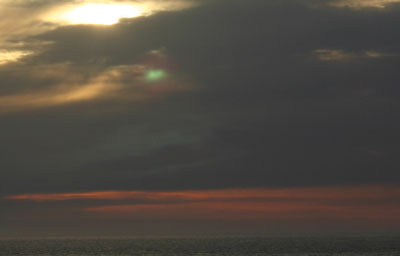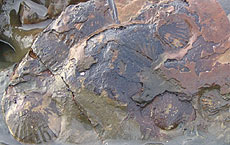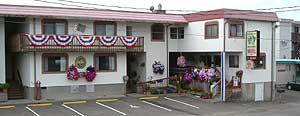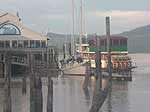 |
The Stranger Everyday Science of Oregon's Coast |
|---|
Covering 180 miles of Oregon coast travel: Astoria, Seaside, Cannon Beach, Manzanita, Nehalem, Wheeler, Rockaway, Garibaldi, Tillamook, Oceanside, Pacific City, Lincoln City, Depoe Bay, Newport, Waldport, Yachats & Florence.
06/23/08
Secrets of the Season |
The Stranger Everyday Science of Oregon's Coast
 |
| Geologic oddity found at Fogarty State Park (see below for more) |
(Oregon Coast) - The ocean and the neighboring beaches are the most dynamic environments on Earth, and often yield the biggest, freakiest surprises, if you know where to look. On the surface, Oregon’s coastline is one beautiful chunk of scenery and repose after another, but dig just a little deeper, look a little closer, and you'll see whole worlds beneath your feet or nearby that you didn’t imagine possible. In fact, some of these oddities lurk in the sky - even in the sunset.
The Green Flash At Sunset
Notice the greenish haze of a blob poking through the cloud layers here at sunset.
 It’s
so rarely photographed that some science people still don’t believe
it exists. But it does, and as crowds of strangers gather together at
certain vantage points to watch summer sunsets, you now often hear someone
else around you talk about hoping to see the famed “green flash.”
It’s
so rarely photographed that some science people still don’t believe
it exists. But it does, and as crowds of strangers gather together at
certain vantage points to watch summer sunsets, you now often hear someone
else around you talk about hoping to see the famed “green flash.”
Newport’s Bob Trusty, owner of Village Market & Deli, photographed this oddity once – albeit a really strange incarnation of it. The green flash is defined as a small, greenish blob you see just above the setting sun, just a second or so before it dips away below the horizon. Certain conditions must exist for you to see it: mainly clear skies with no clouds or fog between you and the horizon.
 Yet
somehow, Trusty caught a singular version of this that BeachConnection.net’s
research has not been able to find. There are certain categories of the
green flash, and none of the literature includes this one.
Yet
somehow, Trusty caught a singular version of this that BeachConnection.net’s
research has not been able to find. There are certain categories of the
green flash, and none of the literature includes this one.
One site, by a man named James Young, features some stunning examples of the green flash on the Oregon coast. His photos are more like what you will see. He explains it this way on the website:
"This phenomenon occurs as the last part of the sun sets in the thick layers of the earth's atmosphere. Just a brief explanation about the thickness of the atmosphere on the horizon will aid one's understanding of how this extraordinary event takes place. Looking straight up (overhead, or to one's zenith), you are essentially looking through 1 layer of atmosphere. This is commonly called 'one (1) air mass'. But looking out across the ocean from sea level, the amount of atmospheric 'thickness' just above the ocean is equivalent to an air mass of 107! This concentrated atmospheric thickness acts like a weak prism, so that as the sun sets, the last sliver of the sun's disk is broken up into a mini spectrum. Since the green light (the predominate color the eye is sensitive to) along with the blue is refracted slightly more than the red end of the spectrum, they remain visible for up to a few seconds longer, thus the brief 'flash' of color."
 |
| Scallop fossil found in the cliff wall near Oswald West |
Ancient History in the Rocks
In the summer of 2003, BeachConnection.net found this intriguing object embedded in the rock while wandering the hard-to-traverse rocky chunks of a hidden beach spot around Oswald West State Park (at the end of Falcon Cove Road).
Newport fossil and beach expert Guy DiTorrice clued us all in.
He said it was a "rock scallop, seen from the interior, with the hinge line on the left side. Take a wire brush to it and you'll see the high-sheen polish. The backside (still embedded) will be ruffled design, usually pocked with worm- and clam-drilled holes."
|
Arch
Cape Property Services.
Dozens of homes in that dreamy,
rugged stretch between Cannon Beach and Manzanita known as Arch
Cape. Oceanfront and ocean view , or just a short walk from the
sea. |
So, what is a "rock scallop?" we asked. It sounded as if it had something to do with that old B-52's song, "Rock Lobster."
He said they are non-swimming scallops that attach themselves to rocks near the shore. He added the scallop is the logo shape used by Shell Oil Co.
The next logical question then is: how old might this fossil be? Guy said the brownish rock color indicates Astoria Sandstone, which "could be as young as 12 million years old, and as old as 17 million."
If that's not cool enough, Guy provided some interesting tips about their modern-day descendants. "They are great eating, have much larger muscles (the meat) than the commercially-harvested swimming scallop cousins."
DiTorrice is known as "Fossil Guy," leading tours around Central Coast beaches to show you how to find all kinds of fossils. www.OregonFossilGuy.com (541) 961-1762.
 What
is Sea Foam?
What
is Sea Foam?
The billows of soapsuds that occasionally litter the beaches aren't from pollution. According to Bill Hanshumaker at the Hatfield Marine Science Center, sea foam is created from the breakdown of the skeletons of tiny single-celled plants called phytoplankton. When high wind and waves churn air into the water, their dissolved organic matter helps to create bubbles.
Protein from the dead microscopic plants increases the seawater's surface tension, producing bubbles when air is added.
You can find the Hatfield Marine Science Center at 2030 Marine Science Dr. in Newport, Oregon. (541) 867-0167.
 Geologic
and Fossil Oddities at Fogarty Creek
Geologic
and Fossil Oddities at Fogarty Creek
Looking for some signs of fossils on your own? This little state park, south of Lincoln City, hides a bundle of wacky objects. Depending on sand levels, you’ll find freaky caves, chunks of rocks with tons of ancient creatures still inside, and geologic shapes that defy description. Not to mention, the dark sand grains here are extraordinarily large – enormous by grains of sand standards. They actually hurt to walk on barefoot.
|
Tradewinds Motel, Rockaway Beach. All rooms are immaculate and have TV’s, VCR’s and in-room phones w/ data ports. Oceanfronts have queen bed, a double hide-a-bed, kitchen, cozy firelog fireplace and private deck. Both types sleep up to four people. Others are appointed for a two-person romantic getaway, yet still perfect for those on a budget. Elaborate oceanfront Jacuzzi suite has two bedrooms, kitchen, double hide-a-bed, fireplace and private deck, sleeping as many as six. For family reunions or large gatherings such as weddings, some rooms can connect to create two-room and three-room suites. Some rooms pet friendly. 523 N. Pacific St., Rockaway Beach. (503) 355-2112 - 1-800-824-0938. www.tradewinds-motel.com |
 Inn
at Cannon Beach. Beautifully wooded natural setting at quiet south
end of Cannon Beach. Great during winter storms with a new book by
the fireplace – or when the sun is out for family fun and beach
strolling. Handsome beach cottage-style architecture. Lush flowering
gardens and naturalized courtyard pond. Warm, inviting guest rooms.
Continental buffet breakfast. Warm Cookies. Family and Pet Friendly.
Welcome gifts. Smoke-free. Complimentary Wireless Connectivity. Wine
and book signing events. 800-321-6304 or 503-436-9085. Hemlock At
Surfcrest, Cannon Beach, Oregon. www.atcannonbeach.com. Inn
at Cannon Beach. Beautifully wooded natural setting at quiet south
end of Cannon Beach. Great during winter storms with a new book by
the fireplace – or when the sun is out for family fun and beach
strolling. Handsome beach cottage-style architecture. Lush flowering
gardens and naturalized courtyard pond. Warm, inviting guest rooms.
Continental buffet breakfast. Warm Cookies. Family and Pet Friendly.
Welcome gifts. Smoke-free. Complimentary Wireless Connectivity. Wine
and book signing events. 800-321-6304 or 503-436-9085. Hemlock At
Surfcrest, Cannon Beach, Oregon. www.atcannonbeach.com. |
|
The Ocean Lodge. There will not be another property built like this in Cannon Beach in our lifetimes. Rare, premiere ocean front location; handsome, dramatic architecture and tasteful, fun (nostalgic) beach interiors. Overlooks Haystack Rock. 100 percent smoke free. Imaginative special occasion packages. Massive wood burning lobby fireplace. Library w/ fireplace, stocked with impressive book collection. Pet and family friendly. Lavish continental buffet breakfast. In-room fireplaces, mini-kitchens. Jacuzzi tubs in select rooms. DVD players, complimentary movies. Morning paper. Warm cookies. 888-777-4047. 503-436-2241. 2864 Pacific Street. Cannon Beach, Oregon. www.theoceanlodge.com |
RELATED STORIES
Click here for video of Dec. storm aftermath
Oregon Coast Best of Awards for the Year And the winners are: best of Oregon coast restaurants, lodgings, science, odd events in nature and stunning moments for 2007
Watching Transformations of Oregon Coast Beaches Seasons change and so do beaches, revealing different sides and a variety of eye-popping sights
Staggeringly Cool Ideas for Oregon Coast Romance Be it the season of Valentine's or be it any time of the year, Oregon's coastline has essentially cornered the market for cuddle-inducing possibilities and gushy activities for the hand-holding set
Day or Night Mysteries and Merriment on Oregon Coast It's more than just nightlife that comes to life, but the beaches offer major opportunities
Oregon Coast Travel Site Goes Wireless Provides Lodging Reports - Oregon Coast Beach Connection now has mobile lodging and dining listings, along with weekly lodging availability reports
|
Oregon coast mileage chart & map Day trips, suggested itineraries Search for Oregon Coast Subjects, Articles Oregon Coast Complete Guides every beach access, attraction |
|||||||||||||
OR
TAKE THE VIRTUAL TOUR |
|||||||||||||
|




































